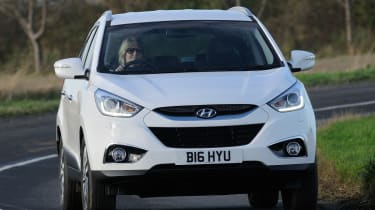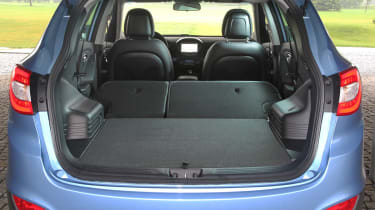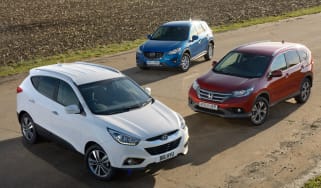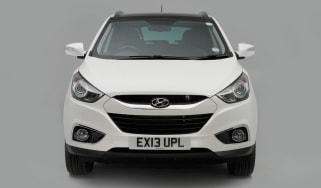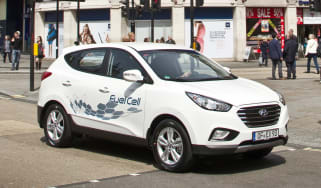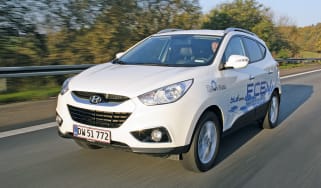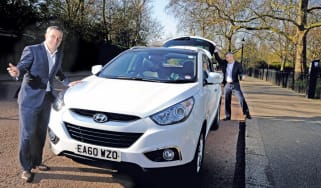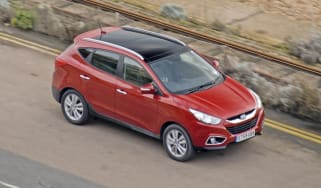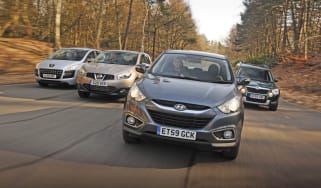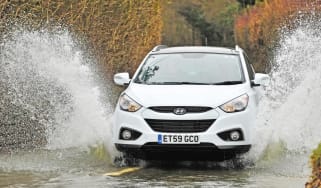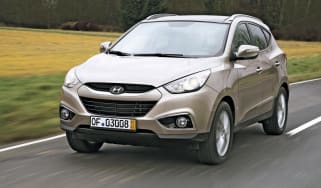Hyundai ix35 (2009-2016) review
The Hyundai ix35 is a practical alternative to the Nissan Qashqai and Mazda CX-5, but it's getting on a bit now

The market for small crossovers is booming, and the ix35 is Hyundai's entrance into this crowded segment. It's designed to rival cars like the Nissan Qashqai, Skoda Yeti and Kia Sportage, and contains Hyundai's hallmarks of a practical design and long warranty. The ix35 is available with the standard array of petrol and diesel engines, but it also forms the basis of the UK's first commercially available hydrogen-fuelled vehicle - the ix35 FCEV.
All models feature raised suspension, space for five and a well-specced interior – backed up by a confidence-inspiring five-year warranty. Buyers can choose from S, SE, SE Nav, Premium and Premium Panorama models, with all versions getting air-conditioning, alloy wheels, LED daytime running lights and a height adjustable driver’s seat. Move up to the SE and you’ll benefit from front and rear heated seats, Bluetooth phone connection, parking sensors and a leather steering wheel, while the SE Nav adds an intuitive touchscreen sat-nav system. Premium models feature all this kit plus leather seat trim, bi-xenon headlamps and keyless entry, while the Premium Panorama gets a full-length glass roof.
The engine line-up comprises two CRDi diesels – 114bhp 1.7-litre and 134bhp 2.0-litre – plus a rather breathless 133bhp 1.6-litre petrol. This unit and the smaller diesel are front-wheel drive only, while the flagship 2.0-litre CRDi comes with the brand’s electronically controlled four-wheel drive transmission. All models get a six-speed manual gearbox as standard, while the 2.0-litre diesel can also be ordered with a six-speed automatic. In addition to these, Hyundai launched the ix35 FCEV hydrogen fuel cell vehicle in 2015, boasting zero tailpipe emissions and a 369 mile range.
More reviews
Regardless of which engine you choose, all ix35 models deliver a hassle-free driving experience. Light controls, a commanding driving position and decent visibility make the Hyundai easy to place on the road, while decent refinement means long motorway journeys aren’t a chore. It’s not as engaging as a Skoda Yeti or Nissan Qashqai, but ix35 is safe and predictable, particularly the grippy four-wheel drive versions.
All models deliver plenty of family-friendly practicality, thanks to a vast 591-litre boot (436 litres on the FCEV) and plenty of useful storage. However, there’s less room in the rear for passengers than in some rivals – a problem that’s compounded by the rather narrow door openings.
Engines, performance and drive
When it was refreshed in 2013, the ix35 was treated to an overhauled suspension set-up. The adoption of new dampers and side-load coil springs promised to deliver sharper handling to suit the UK’s tight and twisty roads.
However, on the road these changes are hard to detect. The ix35 feels reasonably composed over bumps, but there’s too much body roll through corners, while the lifeless steering fails to inspire confidence.
On the plus side, excellent visibility and a commanding driving position make the Hyundai a doddle to drive around town, while decent refinement helps take the strain out of long journeys.
Go for the top-spec 134bhp 4x4 2.0 CRDi diesel and the ix35 is an effortless cruiser, with plenty of overtaking ability in reserve, but it’s costly to buy. The 1.6-litre petrol is the cheapest but feels underpowered - it takes 11.1seconds to complete the 0-62mph sprint before reaching a 111mph top speed, As a result, the 114bhp 1.7 CRDi engine a good compromise, with its engine delivering decent mid-range acceleration. The 2.0 CRDi auto is smoother, but it impacts significantly on performance and efficiency.
In addition to the petrol and diesel models, Hyundai also offers a curveball alternative. The ix35 FCEV fuel cell runs on hydrogen and can be filled in just three minutes from one of the UK's fifteen hydrogen filling stations. It's expensive to buy and not particularly quick, but it's completely silent and emits zero g/km of CO2.
MPG, CO2 and Running Costs
The cleanest ix35 is the new FCEV fuel cell. It is the UK's first commercially available hydrogen vehicle, and emits 0g/km of CO2. You can refill the tank in just three minutes, but as there are currently only 15 filling stations nationwide, you'll have to plan your journeys quite carefully if you want to use it as your only car. It's expensive to buy, too, costing more than £20,000 more than its closest rival – the Mitsubishi Outlander PHEV.
Next best, is the 2WD 1.7 CRDi BlueDrive which returns fuel economy and CO2 emissions of 54.3mpg and 135g/km, which isn't as low as some rivals. The non-BlueDrive model bumps this up to 53.3mpg and 139g/km respectively, making very little difference in the real world. Go for the more powerful, four-wheel drive 2.0 CRDi Auto in Premium spec and those figures become 40.4mpg and 183g/km.
A five-year warranty helps to guard against repair bills in the long term and Hyundai also offers a £499 pre-paid servicing pack (£399 on petrol models), which covers routine maintenance for 36 months and 30,000 miles. Our experts predict that it’ll hold on to around 50 per cent of its new price over three years.
Top spec Premium models come a long standard equipment list that wouldn’t look out of place on a luxury limo yet still manages to be cheaper than rivals from Honda and Mazda.
Interior, design and technology
Hyundai has gone for bold with the design of the ix35, with a distinctive mix of creases and curves, slab sides and tall stance. It looks a little awkward from some angles, but it certainly stands out from the crowd.
All versions get eye-catching LED running lights, alloy wheels plus body-coloured bumpers and door mirrors, while SE versions and above benefit from silver-finish roof rails. Optional extras such as bi-xenon headlamps, 18-inch alloys and chrome door handles (standard from Premium upwards) give an extra visual lift.
The interior isn’t quite as boldly designed, but it’s stylish enough and well built. There are plenty of soft-touch materials, the switchgear operates with precision, the blue backlighting gives a classy feel at night and the high-set driving position provides a commanding view. Entry models are sparsely equipped, but SE versions and above feature heated front and rear seats, dual-zone climate control, Bluetooth, automatic headlights and a leather steering wheel.
Go for Premium and you’ll be treated to the brand’s upgraded navigation set-up – also, unsurprisingly, fitted to SE Nav – which features an intuitive seven-inch touchscreen and extremely clear sat-nav mapping.
Practicality, comfort and boot space
Given its large exterior dimensions, it’s no surprise to find the ix35 makes a reasonably practical family car. Its boot opening isn’t as wide as that in either a Mazda CX-5 or a Honda CR-V, for example, although the boot floor is flat and there’s a decent 591 litres of boot space. This stretches to 1,436 litres with the rear seats folded – but there are no handy remote release levers in the luggage area.
Still, you get a useful hidden compartment under the false boot floor, plus a number of shopping bag hooks, a 12V power supply and a luggage net. Elsewhere in the cabin you’ll find plenty of storage for odds and ends, including large door bins, a deep cubby under the front centre armrest and an air-conditioned glovebox. And while the hard plastic that covers the backs of the front seats looks a little cheap, the finish is tough and simple to keep clean. In the back, legroom isn't great for a car of this size, while access to the bench is hindered by the narrow door openings.
The FCEV hydrogen fuel cell model isn't quite as practical as the other models, thanks to the huge tank fitted beneath the boot floor. Bootspace stands at 436 litres, creating a slight lip above the bumper. It's not as bad as it sounds, though, and still out-punches the Volkswagen Golf.
Towing
On the plus side, the flat floor means those sitting in the middle seat get plenty of foot space. If you’re thinking of using the ix35 for caravan holidays, the towing capacity ranges from 750kg (unbraked) to 1200kg (braked).
Reliability and Safety
In recent years, Hyundai’s forged a strong reputation for durability – and the ix35 has been one of its star performers. Overall it may have taken a nosedive in our Driver Power satisfaction survey, finishing 124th overall, but reliability should still be good – backed up by the manufacturer's five-year, unlimited mileage warranty.
The ix35 also has a strong safety record, with a five-star Euro NCAP rating. All cars get six airbags, stability control and active head restraints, while 4WD is an option on 2.0-litre diesels. However, although Hill-start Assist and pre-tensing seatbelts are standard, there’s no optional lane keep assist, blind spot monitoring or collision avoidance kit.
For an alternative review of the latest Hyundai ix35 SUV visit our sister site carbuyer.co.uk
